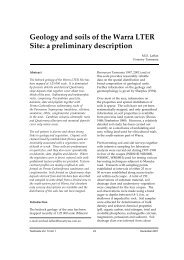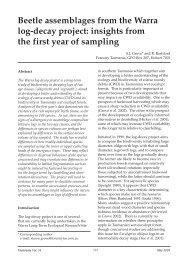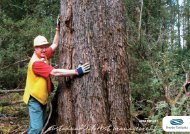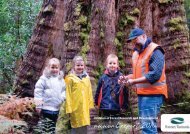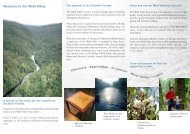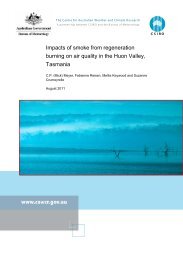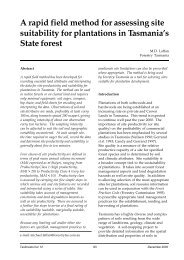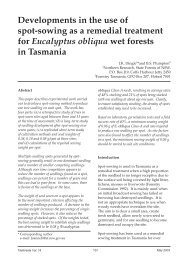The natural distribution of Eucalyptus species in Tasmania - Forestry ...
The natural distribution of Eucalyptus species in Tasmania - Forestry ...
The natural distribution of Eucalyptus species in Tasmania - Forestry ...
Create successful ePaper yourself
Turn your PDF publications into a flip-book with our unique Google optimized e-Paper software.
<strong>Eucalyptus</strong> archeri<br />
SUBGENUS: Symphyomyrtus<br />
SERIES: Vim<strong>in</strong>ales<br />
Common name:<br />
Archer's gum<br />
alp<strong>in</strong>e cider gum<br />
Figure 6. Distribution <strong>of</strong><br />
E. archeri <strong>in</strong> <strong>Tasmania</strong>.<br />
<strong>Eucalyptus</strong> archeri is a localised endemic<br />
<strong>species</strong> associated with cold, relatively<br />
poorly dra<strong>in</strong>ed, shallow, peaty soils <strong>of</strong> rocky<br />
outcrops at, or immediately below, tier and<br />
plateau escarpments along the northern edge<br />
<strong>of</strong> the Central Plateau and mounta<strong>in</strong>s <strong>of</strong> the<br />
north-east (Figure 6). It has been treated as<br />
a sub<strong>species</strong> <strong>of</strong> E. gunnii by some authors<br />
(Pryor and Johnson 1971; Potts and Reid 1985<br />
a, b) but is treated as a separate <strong>species</strong> by<br />
Curtis and Morris (1975) and Chippendale<br />
(1988). It <strong>in</strong>tergrades cl<strong>in</strong>ally with E. gunnii<br />
follow<strong>in</strong>g a gradient <strong>of</strong> decreas<strong>in</strong>g ra<strong>in</strong>fall<br />
and <strong>in</strong>creas<strong>in</strong>g frost severity on the Central<br />
Plateau but, <strong>in</strong> the north-east, the habitats<br />
<strong>of</strong> these two <strong>species</strong> are geographically<br />
separated (Potts 1985; Potts and Reid 1985a, b).<br />
<strong>Eucalyptus</strong> archeri occurs at altitudes above<br />
980 m but is predom<strong>in</strong>ant between 1100 m to<br />
1200 m throughout its range (Figure 7), and<br />
extends to 1350 m <strong>in</strong> the north-east on Ben<br />
Lomond. <strong>The</strong> lowest altitude site occurs<br />
on Mount Foster on F<strong>in</strong>gal Tier. <strong>The</strong> ma<strong>in</strong><br />
flower<strong>in</strong>g period is January to April, peak<strong>in</strong>g<br />
<strong>in</strong> February and March (Figure 8).<br />
Tasforests Vol. 8 51<br />
December 1996




